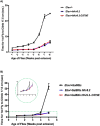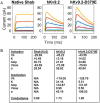A Drosophila Model of Essential Tremor
- PMID: 29769701
- PMCID: PMC5955955
- DOI: 10.1038/s41598-018-25949-w
A Drosophila Model of Essential Tremor
Abstract
Essential Tremor (ET) is one of the most common neurological diseases, with an estimated 7 million affected individuals in the US; the pathophysiology of the disorder is poorly understood. Recently, we identified a mutation (KCNS2 (Kv9.2), c.1137 T > A, p.(D379E) in an electrically silent voltage-gated K+ channel α-subunit, Kv9.2, in a family with ET, that modulates the activity of Kv2 channels. We have produced transgenic Drosophila lines that express either the human wild type Kv9.2 (hKv9.2) or the ET causing mutant Kv9.2 (hKv9.2-D379E) subunit in all neurons. We show that the hKv9.2 subunit modulates activity of endogenous Drosophila K+ channel Shab. The mutant hKv9.2-D379E subunit showed significantly higher levels of Shab inactivation and a higher frequency of spontaneous firing rate consistent with neuronal hyperexcitibility. We also observed behavioral manifestations of nervous system dysfunction including effects on night time activity and sleep. This functional data further supports the pathogenicity of the KCNS2 (p.D379E) mutation, consistent with our prior observations including co-segregation with ET in a family, a likely pathogenic change in the channel pore domain and absence from population databases. The Drosophila hKv9.2 transgenic model recapitulates several features of ET and may be employed to advance our understanding of ET disease pathogenesis.
Conflict of interest statement
The authors declare no competing interests.
Figures








Similar articles
-
Modification of delayed rectifier potassium currents by the Kv9.1 potassium channel subunit.Hear Res. 2000 Sep;147(1-2):21-30. doi: 10.1016/s0378-5955(00)00117-9. Hear Res. 2000. PMID: 10962170
-
Subunit assembly and domain analysis of electrically silent K+ channel alpha-subunits of the rat Kv9 subfamily.J Neurochem. 1999 Apr;72(4):1725-34. doi: 10.1046/j.1471-4159.1999.721725.x. J Neurochem. 1999. PMID: 10098883
-
New modulatory alpha subunits for mammalian Shab K+ channels.J Biol Chem. 1997 Sep 26;272(39):24371-9. doi: 10.1074/jbc.272.39.24371. J Biol Chem. 1997. PMID: 9305895
-
Structural determinants of the regulation of the voltage-gated potassium channel Kv2.1 by the modulatory α-subunit Kv9.3.J Biol Chem. 2003 May 16;278(20):18154-61. doi: 10.1074/jbc.M213117200. Epub 2003 Mar 17. J Biol Chem. 2003. PMID: 12642579
-
Electrically silent Kv subunits: their molecular and functional characteristics.Physiology (Bethesda). 2012 Apr;27(2):73-84. doi: 10.1152/physiol.00023.2011. Physiology (Bethesda). 2012. PMID: 22505664 Review.
Cited by
-
Gene expression analysis of the cerebellar cortex in essential tremor.Neurosci Lett. 2020 Mar 16;721:134540. doi: 10.1016/j.neulet.2019.134540. Epub 2019 Nov 7. Neurosci Lett. 2020. PMID: 31707044 Free PMC article.
-
Understanding and Treating Niemann-Pick Type C Disease: Models Matter.Int J Mol Sci. 2020 Nov 26;21(23):8979. doi: 10.3390/ijms21238979. Int J Mol Sci. 2020. PMID: 33256121 Free PMC article. Review.
-
Current Opinions and Consensus for Studying Tremor in Animal Models.Cerebellum. 2019 Dec;18(6):1036-1063. doi: 10.1007/s12311-019-01037-1. Cerebellum. 2019. PMID: 31124049 Free PMC article. Review.
-
Etiologic links between environmental and lifestyle factors and Essential tremor.Ann Clin Transl Neurol. 2019 May 1;6(5):979-989. doi: 10.1002/acn3.758. eCollection 2019 May. Ann Clin Transl Neurol. 2019. PMID: 31139697 Free PMC article. Review.
References
Publication types
MeSH terms
Substances
Grants and funding
LinkOut - more resources
Full Text Sources
Other Literature Sources
Medical
Molecular Biology Databases

